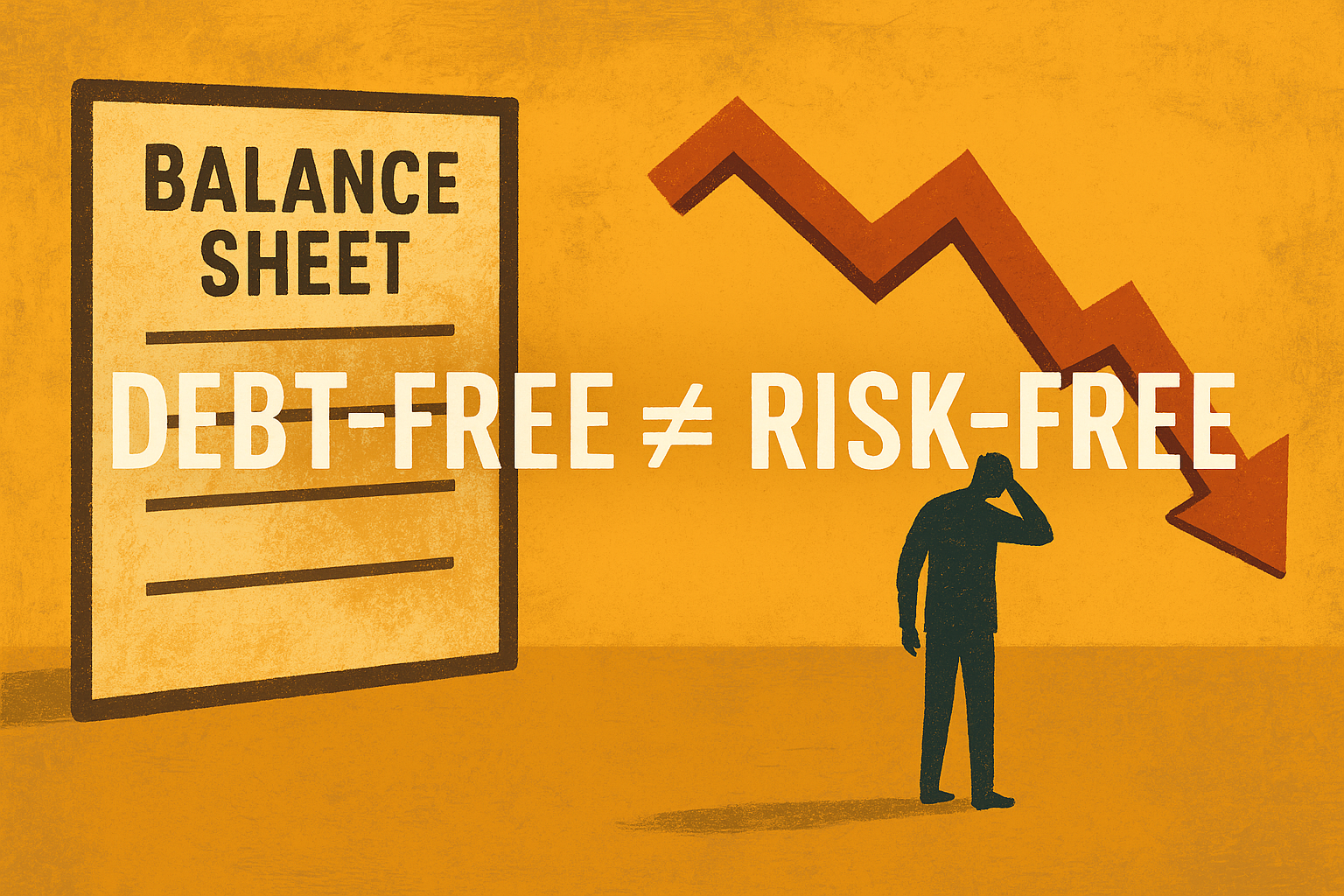We’ve long celebrated debt-free companies as the paragons of financial discipline. The narrative goes something like this: if a company has no borrowings, it’s free from interest obligations, enjoys greater operational flexibility, and can better withstand economic shocks. Shareholders rejoice as these firms generate robust cash flows, pay healthy dividends, or reinvest to fuel future growth.
This is, of course, largely true. A pristine balance sheet often signals sound financial management. But here’s the twist—zero debt doesn’t make a stock bulletproof.
Debt-free is not the same as risk-free.
A company might have no leverage and still wrestle with thin margins, execution missteps, regulatory hurdles, or mounting competition. Sometimes, the absence of debt isn’t by design—it’s because lenders steer clear altogether. The critical question for investors then becomes: Is this company genuinely robust, or are there cracks behind the clean facade?
Let’s explore this through three debt-free Indian stocks—Mazagon Dock Shipbuilders, Indraprastha Gas, and Sirca Paints—that exemplify how risk can lurk beneath the surface.
Mazagon Dock: Defence Darling or One-Trick Pony?
Mazagon Dock Shipbuilders has dazzled the market, posting a staggering 3,600% return over five years, riding high on India’s defence manufacturing boom. Established in 1774, it’s the country’s sole shipyard capable of constructing destroyers, submarines, and corvettes for the Indian Navy.
Its debt-free status since FY16, alongside minimal debt in peers like Cochin Shipyard, underlines its conservative capital structure. But beneath this robust exterior lies a critical vulnerability: overdependence on a single customer—the Ministry of Defence.
Mazagon’s revenue is inextricably tied to defence orders, leaving it at the mercy of policy changes, budget cuts, and procurement delays. Shipbuilding projects are inherently long-gestation, taking four to six years to complete, and revenues are recognized progressively, heightening sensitivity to execution hiccups.
In Q4FY25, this vulnerability was laid bare. Despite a solid order book, revenue edged up a mere 2.3% year-on-year, while margins collapsed by 14 percentage points to just 3%, dragging net profit down 51% to ₹327 crore. A surge in provisions for potential contract losses and rising subcontracting costs played spoiler.
Moreover, the company’s margin guidance has turned cautious—profit-before-tax margins are projected to drop to 15%, a far cry from the recent 25-26%.
Mazagon’s acquisition of Colombo Dockyard further complicates the picture. While it promises to boost revenue by 25%, the Sri Lankan firm is loss-making and heavily indebted, potentially eroding Mazagon’s clean balance sheet and profitability.
Bottom line? At a rich P/E of 52, the stock offers little buffer for future disappointments. Investors seduced by its past performance must weigh these emerging risks carefully.
Indraprastha Gas: Between Gas Cuts and Electric Dreams
Indraprastha Gas Ltd (IGL), a debt-free city gas distributor, finds itself cornered by shifting policy and technological trends.
IGL relies heavily on subsidized domestic natural gas to supply CNG for vehicles and PNG for households. But India’s domestic gas production is declining as existing fields mature. The government’s decision to cut allocations twice in one year, most recently by 20% in November 2024, forced IGL to procure more expensive alternatives like spot LNG.
The immediate consequence? Margins under pressure. Care Ratings predicts a five-percentage-point erosion in profitability for FY26. Market sentiment already reflects these worries—IGL shares plummeted 20% on the day of the latest allocation cut.
A longer-term existential threat looms from electric vehicles. Delhi, IGL’s core market (where 75% of its CNG revenue originates), is rapidly adopting EVs. As cleaner electric mobility gains momentum, demand for CNG could shrink meaningfully.
Financials highlight the stagnation: revenue has hovered around ₹14,000 crore for three years, with net profit fluctuating without a clear growth trajectory.
Though its P/E of 17 appears inexpensive relative to history, it signals the market’s apprehension about future growth and regulatory headwinds.
Lesson? A debt-free tag offers no insulation against shifting policy landscapes or structural demand declines.
Sirca Paints: Premium Positioning with Cracks Beneath
Sirca Paints is admired for its debt-free balance sheet and premium niche in wood finishes, supplied under its Sirca and Unico brands. Its revenue rose sharply from ₹264 crore in FY23 to ₹374 crore in FY25. Yet, profit has remained flat, stuck in the ₹46–49 crore range.
What’s behind this paradox? Rising competition, notably from Birla Opus, which has rapidly grabbed 6.1% of the market, mainly at the expense of larger players. Though Sirca’s market share is only about 0.6%, its premium positioning makes it especially vulnerable to aggressive pricing and discounting pressures.
Add to that the volatility in crude oil derivatives, which account for 40% of Sirca’s raw material costs. As global oil markets swing, input costs rise, further squeezing margins.
While debt-free peers like Asian Paints and Berger carry some leverage, they also have broader product portfolios and stronger scale advantages. Sirca’s small size and niche focus may make it a takeover target, or force it into deeper discounts to protect market share.
Takeaway? A debt-free balance sheet offers a strong foundation, but without competitive resilience and pricing power, it isn’t enough to guarantee sustained shareholder value.
The Bigger Picture: Beyond the Balance Sheet
Mazagon Dock’s order dependency, IGL’s regulatory and demand shocks, and Sirca’s competitive fragility highlight one crucial truth: being debt-free isn’t synonymous with being risk-free.
Investors need to look beyond the numbers in financial statements and scrutinize business models, margin trends, competitive dynamics, and growth trajectories. Earnings growth and quality of execution ultimately drive long-term returns—not just the absence of debt.
So next time you’re tempted to buy into a “debt-free” stock story, ask yourself: What’s lurking behind that clean balance sheet?
Feel free to share your experiences and insights in the comments below. Let’s continue the conversation and grow together as a community of traders and analysts.
By sharing this experience and insights, I hope to contribute to the collective knowledge of our professional community, encouraging a culture of strategic thinking and informed decision-making.
As always, thorough research and risk management are crucial. The dynamic nature of financial markets demands vigilance, agility, and a deep understanding of the tools at your disposal. Here’s to profitable trading and navigating the election season with confidence!
Ready to stay ahead of market trends and make informed investment decisions? Follow our page for more insights and updates on the latest in the financial world!
For a free online stock market training by Yogeshwar Vashishtha (M.Tech IIT) this Saturday from 11 am – 1 pm, please sign up with https://pathfinderstrainings.in/training/freetrainings.aspx
Experience profits with my winning algo strategies – get a free one-month trial with ₹15 lakh capital! – https://terminal.algofinders.com/algo-terminal
Disclaimer
This article should not be interpreted as investment advice. For any investment decisions, consult a reputable financial advisor. The author and publisher are not responsible for any losses incurred by investors or traders based on the information provided.


